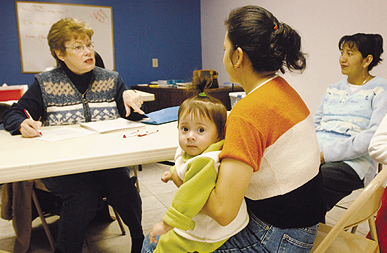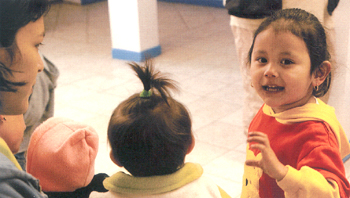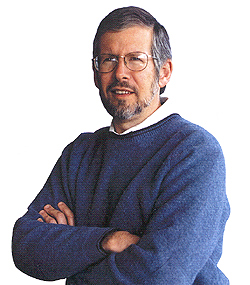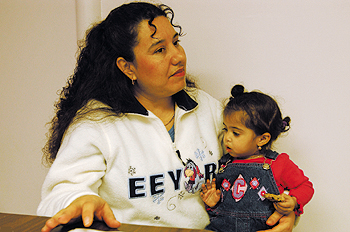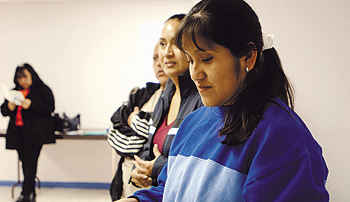Jean Murphy is a registered nurse, fluent in Spanish, and the wife of a minister. But to the Latino women who gather each week at the Chamblee Doraville Ministry Center, she is much more—a teacher, a friendly face in a foreign land, a kind-hearted supporter. For some, she is the only person they know to call in desperate times. As director of the center’s health ministry, Murphy has taken on a daunting job. Her group offers health fairs several times a year, helps clients enroll in Medicaid and Peachcare, and trains health promoters in several multi-ethnic congregations along the Buford Highway corridor. Other services available at the ministry center are English classes and a food pantry. God told us to love everyone who crosses our path and take care of strangers—no matter who they are or where they came from,” Murphy says. To learn how to take better care of these strangers who cross her path, Murphy trained as a health educator with the Interfaith Health Program (IHP), based in the Rollins School of Public Health (RSPH).
Reaping what you sow In 1992, the IHP was officially established with part of its mission to refocus the efforts of religious communities toward disease and injury prevention. Gunderson was named director, and Foege, then director of The Carter Center and a former Lutheran missionary doctor, was chief adviser. Now a part of the RSPH, the IHP has forged a key working relationship with the Centers for Disease Control and Prevention (CDC), training teams of leaders in both faith and health to develop projects that attack racial, ethnic, social, economic, and geographic health disparities. The IHP also works nationwide with state and local health departments and congregations large and small to develop and nurture community health projects. Why? Because the religious community has deep roots in and significant impact on society, says Gunderson, who wrote about the partnership between religion and public health in his book, Deeply Woven Roots. “Religion is a political force, weaving an extraordinarily dense web of social structures that encourage positive behaviors,”Gunderson says. “Religious communities also have the ability to challenge the market forces responsible for health problems like tobacco advertising and marketing, neighborhood drug dealers and gang leaders, and other societal factors that lead to ill health.” Gunderson’s favorite example of a religious group taking a preventive health stand is the response of one church youth group to the marketing of alcohol and tobacco in their central Los Angeles neighborhood. The group picketed liquor stores and wrote across tobacco advertisements posted outside convenience stores and gas stations. “In many low-income communities, almost all of the advertising is drug-related, albeit legal drugs like alcohol and tobacco,” Gunderson says. “This is predatory marketing to low-income, vulnerable people, and community-based groups can effectively confront it.”
While public health, churches, and government may seem like strange partners, when they align their strengths, their impact is magnified. The IHP is one of the largest of 21 intermediary groups chosen by the Department of Health and Human Services (HHS) to disperse $24.8 million to faith-based community health organizations nationwide. Thanks to this initiative, called the Compassion Capital Fund, the IHP will disperse $1.5 million and technical help to organizations through its “Strong Partners” program, a partnership with nine foundations in seven states. These foundations will then allocate their share of the HHS money to community-based groups in their area to improve health. “The logic of the Compassion Capital Fund is to build the capacity of faith communities to be stronger partners with government,” says Gunderson. “We want to help them develop the capacity for enduring partnerships.” Eight of the nine Strong Partners foundations were formed from the sale of hospitals owned and operated by religious groups. To receive grants from the Compassion Capital Fund, these foundations agreed to funnel—and match—grant money to community-based organizations in their local areas. “They bring intelligence about their terrain as well as funding,” says Gunderson, “so we asked them to identify local faith-based groups with the capacity to build more capacity.” These community aid groups support a wide variety of projects, large and small. They alleviate hunger and provide childhood immunizations, dental and health care to recent immigrants, social services, and more. Says Gunderson: “A controversial aspect of this program is building what I call the internal plumbing capacity of these organizations so they can compete with other organizations that now receive federal funds. Some say the religious organizations have been discriminated against, and they should be allowed to compete for federal funding. The point is to end up with more capacity overall, not just to shift the burden.” Gunderson also acknowledges skeptics who wonder if the Compassion Capital Fund crosses the line separating church and state. “It’s an appropriate fear,” he says. “It’s still too early to tell, and there is a facet of political-religious engagement in the United States that is deeply cynical or that has been used to cover and justify different motives. And sometimes even the best intentions have unintended consequences, so we will be watching closely––including the consequences of our own actions.” Gunderson also is alert to some who use the faith community as a “tourniquet” to staunch the increasing need for government health services among the uninsured. “Faith-based health groups should never be seen as an alternative to public structures,” he says. “The faith community must make sure the government doesn’t abuse the relationship to unload responsibilities that are those of government. It would be a terrible abuse if faith structures were used to justify lowering government funding for public health.”
The sisters of charity “The hospital served a large number of senior patients who really depended on it,” says Bridget McDermott Flood, executive director of the foundation. “It was one of the few inner-city hospitals that remained open to serve the poor. But the economics of the modern health care system made it impossible for the sisters to continue to nurse the poor in the traditional way.” The Incarnate Word Foundation now supports a variety of faith-based community aid groups across Missouri. The foundation is matching the $123,288 from the Compassion Capital Fund and using the combined funds to support a diverse assortment of community groups. These groups serve people of all ages from a range of ethnicities, helping both the urban and rural poor gain access to primary health care, food, and clothing. They support alcohol and drug rehabilitation programs both in and out of prison. They also offer English classes and employment services. “The sisters had an especially close relationship with their long-term patients, as well as the physicians and the staff,” says Flood. “Through the foundation, they are still able to serve the poor in very direct ways, and they remain a vital presence in the community. Their work with the poor continues in new ways that were not possible through an institutional ministry.” Much of that work involves preventive health care—a cornerstone of public health. “The sale of religious hospitals to for-profit firms has attracted attention because these transactions could, within the first decades of the new century, provide faith groups with between $15 to $30 billion and pass operational control into new hands with different values,” Foege has written. “The June 1997 issue of Hospitals and Health Networks calls this trend the ‘largest redeployment of charitable assets the country has ever seen.’ Choices are now being made about how people of faith will use their assets for community health. It is critical they reflect our most mature values, and at the same time, our most relevant science.” The IHP is trying to ensure that Foege’s hopes come true.
Transformation Now a leader and trained health promoter in the women’s group, Barajas knows how these women feel because she has been there. She arrived in Chamblee in 1995 with her husband and two children. The family of four lived in one bedroom of another family’s apartment for the first year. They slept on the floor and had few clothes, no car, no money, inconsistent work, and no English. A neighbor invited Barajas to the women’s group, and she says that’s when things began to turn around. “I needed to learn everything—English, the money, where to shop for food, how to find a job, and where to find a doctor for the kids,” she says. “In Mexico, we always had a lot of family nearby, and we had grown up with our neighbors. Here, I felt very alone.” Barajas now comes to the group to help others. She is confident, assertive, and happy to share her knowledge and experience. “My family passed through many troubles and hard times, but God was with us,” she says. “These people need more than food, money, a doctor, and a place to live. They need someone to care, someone to give them a hug.” Murphy says that’s how interfaith health is supposed to work. “It’s been amazing to watch the transformations of women like Argelia. They encourage others to become leaders and keep the process going. The way these women rely on each other is a beautiful thing. We have several like Argelia who have gone full circle. Once they realize they’re not alone—and that people care about them—they can do anything.”
This News Could Save Your Life | An idea, of SORTS | Class Notes Rollins School of Public Health
Copyright © Emory University, 2003. All Rights
Reserved. |
